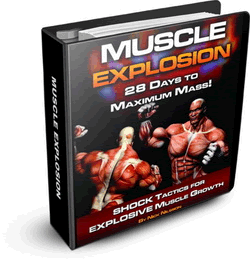By Nick Nilsson
Author of Time-Volume Training
If you've been training awhile, you've no doubt experienced the dreaded "plateau."
It's a terrible place where, no matter how hard you try and no matter what you do, nothing seems to happen. Well, you're in luck...busting plateaus is my speciality.
The Upside Down Training Program is one of my favorite "shake-up" programs and it's a pretty simple one. It's most useful when you find your smaller muscle groups are slowing down in development because, like a good trainer should, you're always doing the "big" exercises (like squats, deadlifts, barbell rows and bench press) first.
It's also VERY useful when you find you're not making progress in your big exercises too. I'll tell you more about THAT as you keep reading.

One of the best ways to smash through a plateau is to go completely OPPOSITE to what all the "rules" of training say.
But then again, I'm not really one to follow the "rules" to begin with.
So today, I'm going to tell you basically (from a training standpoint) when and how to eat your dessert first and why it can work wonders for you in the short term and long term.
Here's the deal...conventional wisdom (a.k.a. the "rules") says "train your largest muscle groups first using the heavier exercises." This is how to you maximize the overall load on your entire body and prioritize your workload. Totally true - nothing wrong with that. Working the big muscles first generally gives you the most bang for your buck.
But what I've found is that eventually, if you keep training the big muscles first, you don't leave a lot of energy for the smaller muscles. Not a big deal for the most part...the simple truth is that the big exercises also tend to work the smaller muscles pretty hard, too.
For instance, if you're doing barbell rows, you can be quite sure your biceps are getting great stimulation as well. The same goes for bench pressing and your triceps.
When it comes to what order to work bodyparts, a standard program might look like this: chest, then shoulders then triceps...or back then biceps...or thighs then calves.
However, now we're going to turn conventional wisdom COMPLETELY UPSIDE DOWN and, for a short time, work the SMALL muscles first and follow that with working the BIG muscles after.
Of course, this totally goes against conventional wisdom, but that's what makes it so effective!
So what are the reasons working the small muscles first can be so effective?
1. It Gives Your Body a Break
If you've been doing the big exercises and training the big muscles for a long time, your body is going to get beaten down. Squats and deadlifts are demanding and pushing yourself hard on those takes its toll. By working the small muscles first, you're going to have less energy to destroy yourself on the big exercises, basically forcing your body to take a break from the constant pounding. This forced back-off results in a rebound effect and can actually increase your strength when you come back to hitting the big exercises first.
2. It Gives Your MIND a Break
Ever have that feeling of dread when you walk up to a fully-loaded bar to do some heavy squats? If so, that's a good sign you need to back off. Working the smaller muscles first changes your whole mindset when it comes to training. Doing a set of heavy pushdowns isn't nearly as daunting as pushing heavy squats. The reduced overall workload on the body also helps your neurological system recover from previous heavy training.
3. Focusing on The Small Muscles Gives THEM a Chance To Grow
With Upside Down Training, you're going to hit the smaller muscles with greater volume, intensity and weight than you normally do, spurring growth and development in those small muscles beyond what they were capable of before. This leads to more rapid results in the smaller parts.
4. Strengthens Your Weak Links
Shoring up and strengthening the smaller muscles (which are usually the weakest links in the big exercises) can have a HUGE impact on your strength on those big exercises. Think of it this way...you'll suddenly have much stronger triceps. How will that affect your bench press, especially if triceps were a weak point of your benching? Your numbers will automatically go up. If your biceps always failed first with heavy rows? Now they can keep up with your back and you get more reps. Your back will grow when you go back to regular training.
Taking these 4 reasons into account, you've got yourself one powerful training program.
So when you do Upside Down Training, you're going to work the small parts FIRST with more sets than the big parts. It's going to feel VERY strange the first time you do it (trust me) and you'll feel like you're doing something wrong.
But perform this Upsidedown program for 3 weeks and you'll see a difference not only in your smaller parts but (after you're done with the program) how you perform in your BIG exercises as well. Plus, it's fun to have the energy to really hit those smaller parts hard.
How To Do Upside Down Training
While there are many ways you can structure this type of program, what I've found to provide the best results is a schedule that increases your training volume (number of sets) week by week while at the same time decreasing your rest periods in between sets. This essentially FORCES adaptation in the muscles by gradually making them do more work in a specific timeframe.
If you've ever used the "Big Beyond Belief" training system that came out a number of years ago, the framework of this program will look familiar to you. The overtraining concept (increase training volume while decreasing rest periods) they make use of in that program is VERY effective! Forcing overtraining through manipulation of these variables is a tried and true method that's been around a long time.
At the end of the 3 weeks, we will switch back to a "bigger-parts-first" type of training style, backing off on the number of sets and increasing the rest periods between sets. Your body will play "catch-up" and you should see some impressive results! You can continue on this back-off program for more than 2 weeks if you find you're still getting good results.
When it comes to exercise selection, try to stick with the "big" type of exercises even for the small bodyparts. For example, for biceps, use barbell curls, incline dumbbell curls, Preacher curls, etc. For triceps, use dips, close grip bench press, lying tricep extensions, etc. For calves, use seated, standing and donkey calf raises. For shoulders, use dumbbell and barbell shoulder press.
When you work with chest, do bench pressing...for back, use barbell rows, chins and deadlifts...and for thighs, squats, stiff-legged deadlifts and leg curls.
In the program outline, I've included suggested rep ranges that I recommend for this program as well. The rep ranges are there to help you select an appropriate weight to use for your sets. Work a weight with which you will reach muscular failure (the point at which you can't do another rep in good form) in and around that rep range. Be sure to push yourself.
When it comes to splitting up the available sets, when the program calls for 4 sets, you can choose to do all 4 sets of the same exercise or mix things up (e.g. doing 2 sets of 1 exercise and 2 sets of another exercise or 3 sets of 1 and 1 set of another). Don't do more than 2 different exercises, though, because then you're spending too much time setting up and taking down exercises.
When you're working the BIG muscles, stick with just ONE exercise to keep things simple, e.g. do all your sets for chest using the bench press.
4 Training Days Per Week - 2 on, 1 off, 2 on, 2 off
I'll tell you how to modify it for a 3 training day schedule at the bottom.
Training Days - Monday, Tuesday, Thursday, Friday
Rest Days - Wednesday, Saturday, Sunday
WEEK 1
Rest period - 90 seconds between sets
| DAY 1 | DAY 2 | DAY 3 |
DAY 4 |
| 13-15 reps | 13-15 reps | 13-15 reps | 13-15 reps |
| (4) Triceps | (4) Biceps | (4) Triceps | (4) Biceps |
| (4) Shoulders | (4) Calves | (4) Shoulders | (4) Calves |
| (2) Chest | (2) Hamstrings | (2) Chest | (2) Hamstrings |
| (2) Thighs | (2) Back | (2) Thighs | (2) Back |
| (2) Abs | (2) Abs |
WEEK 2
Rest period - 60 seconds between sets
| DAY 1 | DAY 2 | DAY 3 | DAY 4 |
| 10-12 reps | 10-12 reps | 10-12 reps | 10-12 reps |
| (5) Triceps | (5) Biceps | (5) Triceps | (5) Biceps |
| (5) Shoulders | (5) Calves | (5) Shoulders | (5) Calves |
| (2) Chest | (3) Hamstrings | (2) Chest | (3) Hamstrings |
| (2) Thighs | (2) Back | (2) Thighs | (2) Back |
| (2) Abs | (2) Abs |
Note how we have decreased the rest time in between sets and increased the number of sets by one. This is the beginning of the increased demand on the body.
WEEK 3
Rest period - 45 seconds between sets
| DAY 1 | DAY 2 | DAY 3 |
DAY 4 |
| 8-10 reps | 8-10 reps | 8-10 reps | 8-10 reps |
| (6) Triceps | (6) Biceps | (6) Triceps | (6) Biceps |
| (6) Shoulders | (6) Calves | (6) Shoulders | (6) Calves |
| (3) Chest | (4) Hamstrings | (3) Chest | (4) Hamstrings |
| (3) Thighs | (3) Back | (3) Thighs | (3) Back |
| (2) Abs | (2) Abs |
This week will be the toughest week. We have increased the number of sets and decreased the rest time again. Towards the end of the week you should be feeling pretty rough!
WEEKS 4 and 5 (and beyond, if you like)
Rest period - 120 seconds between sets
| DAY 1 | DAY 2 | DAY 3 |
DAY 4 |
| 6-8 reps | 6-8 reps | 6-8 reps | 6-8 reps |
| (4) Chest | (4) Back | (3) Back | (3) Chest |
| (4) Thighs | (3) Hamstrings | (3) Chest | (3) Thighs |
| (3) Shoulders | (3) Biceps | (3) Thighs |
(3) Back |
| (3) Triceps | (2) Calves | (1) Shoulders | (1) Shoulders |
| (2) Abs | (1) Hamstrings | (1) Hamstrings | |
| (1) Biceps | (1) Triceps | ||
| (1) Triceps | (1) Biceps | ||
| (1) Calves | (1) Calves |
Note the decrease in rep range, the decrease in the number of sets you are doing, and the increase in rest time. This is the easy phase where your body plays catch-up with recovery. Don't back off on intensity, however. Keep pushing all your exercises to muscular failure!
In these 2 weeks, you're going to be going back to the bigger-parts-first type of thing. You should notice increased strength in your bigger exercises as your smaller part training shored up the weak points of some of your exercises.
As I mentioned above, you can keep going with this program for longer than 2 weeks, as long as you're still seeing results.
Modifying the Program to a 3 Workout Per Week Schedule
As for modifying the 4 day schedule to a 3 day schedule, that's easily done. Basically, do the first two days as-is but just have a day of rest in between. Then for the third session, combine Day 3 and 4 into a single total-body workout.
Here's what that day might look like:
| First Week | Second Week | Third Week |
| 3 biceps 3 triceps 3 calves 3 shoulders 2 hamstrings 1 chest 1 back 1 thighs |
4 biceps 4 triceps 4 calves 4 shoulders 2 hamstrings 1 chest 1 back 1 thighs |
5 biceps 5 triceps 5 calves 5 shoulders 2 hamstrings 2 chest 2 back 2 thighs |
On the "regular" program that you move to after doing 3 weeks on this, just do one of the total-body workouts for that training day.
Conclusion:
If you're ready for a change of pace, take the Upsidedown Training Program for a test drive. I think you'll not only have fun with it but also get great results in both strength and muscle growth. It'll help you blast through your plateaus with ease.
Learn more about the Controlled Overtraining method this program is based on here.
![]()
More From Fitstep.com
| The 4 Most Insane Bodyweight Exercises I've Ever Done | |
| 3 Things People Do To Totally Screw Up Their Fat Loss | |
| 7 Simple Rules for What You Should Eat | |
| Speedskater's Secret For a Bigger Butt |
Share This Page...
---
Home -> Muscle and Strength -> Workouts -> Upside Down Training



